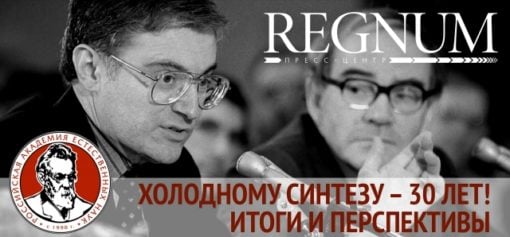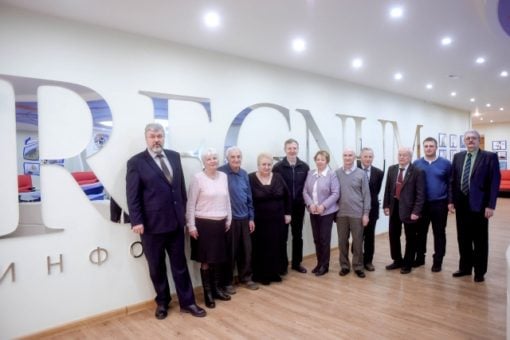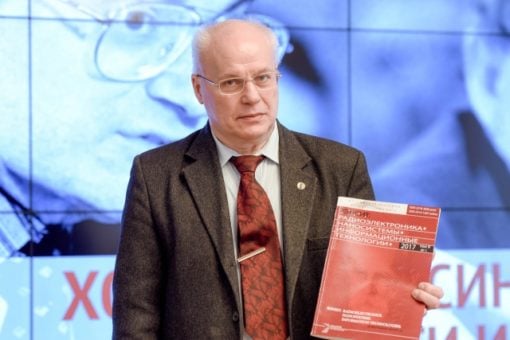This is a re-post of a google-translate of the article first published on Regnum.ru here. Any use of materials is allowed only if there is a hyperlink to REGNUM news agency. The original article has been re-formatted slightly.
On the conference of the Coordination Council on the issue of “Cold nuclear transmutation” of the Russian Academy of Natural Sciences on March 23, 2019, dedicated to the 30th anniversary of the press conference of Martin Fleischmann and Stanley Pons on cold nuclear fusion

On March 23, 2019, the REGNUM press center hosted the30th Anniversary Cold Fusion Synthesis Conference: Results and Prospects, organized by the Coordination Council on the Cold Nuclear Transmutation Problem of the Russian Academy of Natural Sciences (RANS).
The main task of the one-day conference is to tell about the history of cold nuclear fusion research in the USSR and the Russian Federation, about the most promising domestic developments in this area and substantiate the thesis about the beginning of a new phase of cold fusion research – the stage of its industrial implementation.

Participants in the conference of the Russian Academy of Natural Sciences “Cold fusion – 30 years: results and prospects” on March 23, 2019 in Moscow. From left to right: A.S. Sverchkov, L.V. Ivanitskaya, A.V. Nikolaev, A.A. Kornilov, A.I. Klimov, I.B. Savvatimova, A.G. Parkhomov, A.A. Prosvirnov, V.I. Grachev, S.N. Gaydamak, S.A. Flowers
It so happened that this conference was the first event of the Coordination Council, organized more than a year ago. Such a long delay was due to the fact that, in 2018, two of its organizers and co-chair passed away, the theoretical physicist Anri Amvrosiyevich Rukhadze (09.07.1930 — 07.03.2018) the creator of the Soviet beam weapons passed away in July, and the nuclear physicist, the permanent organizer, and the organizer of the Russian and international conferences on cold fusion and ball lightning, Yuri Nikolayevich Bazhutov (04/21/1947 – 03/09/2018) passed away in March.

Anri Amvrosiyevich Rukhadze and Yury Nikolayevich Bazhutov, Organizers of the Coordination Council of the Russian Academy of Natural Sciences for the Cold Kernel Transmutation Problem
By the decision of the Presidium of the Academy of Natural Sciences, a new chairman of the council was elected the chief researcher of the Institute of Physics of the Earth, O. Yu. Schmidt of the Russian Academy of Sciences, Corresponding Member of the Russian Academy of Sciences, Academician of the Russian Academy of Natural Sciences, Doctor of Physics and Mathematics Alexei Vsevolodovich Nikolaev, and his co-chairs were the Physics Faculty of Moscow State University. MV Lomonosov, Academician of the Russian Academy of Natural Sciences Alla Alexandrovna Kornilova, and Anatoly I. Klimov, a member of the Joint Institute for High Temperatures (JIHT RAS), academician of the Russian Academy of Natural Sciences, doctor of physical and mathematical sciences.
Member of the Institute of Physical Research and Technology of the Russian University of Peoples’ Friendship (PFUR), head of the All-Russian Cold Nuclear Fusion and Ball Lightning Seminar since 1993, corresponding member of the Russian Academy of Natural Sciences Nikolai Vladimirovich Samsonenko and corresponding member of the Russian Academy of Natural Sciences Alexander G. Parkhomov were elected deputy chairmen of the board.
The work of board leaders has long been known in the international community of cold fusion researchers. In a flawless experiment, Alla Kornilova proved the possibility of implementing nuclear fusion reactions in microbiological cultures (biological transmutation), and her technology for accelerated deactivation of liquid radioactive waste using a radiation-resistant microbial association, developed in the late 1990s, passed successful state expertise in South Korea, the results of which were published on February 28, 2019 (see Kyou-Jin Yum, Jong Man Lee, Gun Woong Bahng and Shanghi Rhee with An Experiment of Radioactivity of Radionuclide (137Cs) with Multi-component Microorgani sms of 10 Strains).
In terms of its official recognition, the South Korean expertise is a landmark event for the entire scientific field of research on cold fusion, recognition which has already occurred at least in the USA, Canada, Japan, South Korea, India and China. We hope that this will finally happen in Russia.
Today, there are all the conditions for the technology of accelerated microbiological deactivation of liquid radioactive waste and contaminated land to become part of world practice before the cold fusion power reactors are widely used.

Vladimir Grachev, Editor-in-Chief of the Academy of Natural Sciences of Radio Electronics, Nanosystems, and Information Technologies (RENSIT), demonstrates the thematic issue of the journal (# 1, 2017) on cold nuclear fusion
The vortex plasma power reactor of Anatoly Klimov in its parameters is included in the group of world leaders among numerous power plants that use cold nuclear fusion energy. The work of Alexander Parkhomov on “deciphering” the e-cat reactor Andrea Rossi of Russia has become widely known in the world due to its complete openness. Today, the Parkhomov reactor in all respects “comes on the heels” of its secret Italian prototype.
* * *
A few hours after the Russian conference opened, the two-day memorial colloquium at the Massachusetts Institute of Technology (2019 LANR / CF Colloquium at MIT), dedicated to the 30th anniversary of the sensational press conference at the University of Utah, Martin Fleischmann and Stanley Pons, at which they reported that they managed to get a nuclear fusion reaction during the electrolysis of water.
The participants of the Russian conference sent a greeting to the American colloquium:
“Dear colleagues, please accept our warmest regards to the International Colloquium on the 30th anniversary of cold fusion.
We were 30–40 years old when we all united around the idea of cold fusion. For many years, we have conducted research, exchanged knowledge, built models and theories, and everyone has matured a bit during this time. Today, as leaders of this science, we want the thirst for knowledge not to leave us, and for us to manage to pass on our vast experience to the younger generation.
The Russian community of cold fusion researchers wishes all their friends and associates from different countries to see the fruits of the realization of our ideas and results, and have time to enjoy this in the coming years.
Successful work of the International Colloquium and see you soon at the 23rd International Conference in Italy.
Alexey Nikolaev
Alla Kornilova
Vladimir Vysotsky
Irina Savvatimova
Sergey Tsvetkov
Alexander Parkhomov
Anatoly Klimov
Vladimir Balakirev
Valery Krymsky
Nikolay Samsonenko
Vladimir Grachev
Albina Gerasimova
Natalia Famina
March 23, 2019, Moscow. ”
The MIT colloquium also did not go without pleasant surprises. It became known yesterday that the American Classifier of Patents and Trademarks (CPC – Cooperative Patent Classification) in section G21 “Nuclear Fusion Reactors” has introduced a new class of reactors 3/00 “Low-temperature nuclear fusion reactors, including the so-called cold fusion reactors.”

New section in the classification of US patents for low-temperature nuclear fusion rectors (highlighted in red)
March 23, 1989 – the day of the press conference of Martin Fleischmann and Stanley Pons – today is considered to be the date of birth of the direction of cold fusion research. However, we know that Martin Fleischman and Stanley Pons were not sole pioneers of the cold fusion phenomenon, and even the term cold fusion was coined by journalists much earlier, in 1956, in connection with the research of Nobel laureate Luis Alvarez on muon catalysis, one of the “scientifically recognized” options obtain cold nuclear fusion.
Pioneering experimental and theoretical work on cold nuclear fusion within the framework of emerging nuclear physics and quantum mechanics was carried out in the late 1920s and early 1930s. Some results of these forgotten studies for many years have been reproduced at the present experimental level only at the turn of the XX and XXI centuries.
After the end of World War II, the classics of Soviet nuclear physics — Igor Kurchatov, Yakov Zeldovich, Andrei Sakharov, Yevgeny Zababakhin — also wrote about the possibility of implementing cold nuclear fusion.
Why exactly did the poorly reproducible, modest in its results, and frankly “raw” work of Martin Fleischmann and Stanley Pons cause unprecedented interest in the whole world to begin research in cold nuclear fusion? What exactly gave impetus to thousands of highly professional and frankly amateurish research?
The answer to this question will become clear after becoming acquainted with the reports of one of the leading theorists of cold synthesis, Professor of Kiev University T. G. Shevchenko, Academician of the Russian Academy of Natural Sciences Vladimir Ivanovich Vysotsky, member of the NPO Luch, Corresponding Member of the Russian Academy of Natural Sciences Irina Borisovna Savvatimova and Corresponding Member of the Russian Academy of Natural Sciences Sergey Alekseyevich Tsvetkov.
Works on cold fusion by I. B. Savvatimova and S. A. Tsvetkov began, like many other Soviet researchers, literally several days after the press conference of Drs. Fleishman and Pons, and V. I. Vysotsky published his first article on cold fusion back in 1981.
Already in May 1989, the first applications for copyright certificates on cold fusion were filed in the USSR. The work carried out at the highest methodological level by leading specialists of the institutes and nuclear centers of Sredmash and the USSR Academy of Sciences, allowed not only to successfully reproduce the results of Fleischmann and Pons, but also to obtain nuclear fusion reactions using other methods (including shock waves, saturation from the gas phase, cavitation, electrolysis in molten salts, etc.).
At the end of 1990, the Interdepartmental Council for Chemistry and Chemical Technology of the State Committee on Science and Technology of the USSR held a closed competition on the issue “Cold synthesis stimulated mainly by electrochemical means”. According to the results of this competition, and under the guidance of the Director of the Institute of Electrochemistry of the Ural Branch of the Academy of Sciences of the USSR, Academician Alexei Nikolaevich Baraboshkin, the project of the All-Union Cold Nuclear Fusion research program was developed.

Academician Alexei Nikolaevich Baraboshkin (1925–1995), author of the unrealized All-Union research program “Cold Nuclear Fusion” of 1990
The program was not funded due to the collapse of the USSR. Despite this, by the mid-1990s, participants in the program practically solved all the tasks formulated in the draft program, the main ones of which were clarifying the conditions for the reproducibility of cold fusion reactions and determining the most promising directions for its use.
After the death of academician A.N., since 1998, Baraboshkina began the shameful scientific period of the existence of cold fusion, shameful for the Russian Academy of Sciences, which continues in Russia today. How did they almost completely forget the Soviet achievements in the study of cold fusion – one of the many “mysteries” of post-Soviet Russia?
In any case, today we are grateful to Martin Fleischmann and Stanley Pons for their civic courage, for their press conference that violated the canons of scientific communications, but played the role of a trigger to study the numerous “anomalous” manifestations of cold fusion accumulated by that time in nuclear physics, materials science, plasma physics, catalysis, biophysics, geology and other scientific disciplines.
All reports of the participants of the conference “Cold Synthesis – 30 years” will be published on the site of IA REGNUM and on the site of the Russian Academy of Natural Sciences.
by Andrey Sverchkov
Conference of the Russian Academy of Natural Sciences “Cold fusion – 30 years” is a re-post of a slightly reformatted google-translate of the article first published on Regnum.ru here. Any use of materials is allowed only if there is a hyperlink to REGNUM news agency.
Juxtapositional ending: Here is a photo taken from the 1st Russian Cold Fusion Conference. Can you name these pioneers of science?–Ruby Carat

